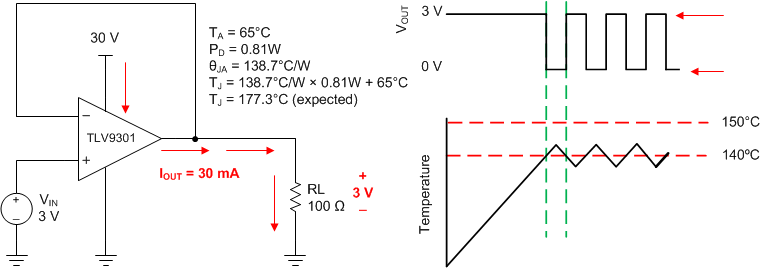JAJSUS7 June 2024 TLV9304-Q1
PRODMIX
- 1
- 1 特長
- 2 アプリケーション
- 3 概要
- 4 Pin Configuration and Functions
- 5 Specifications
- 6 Detailed Description
- 7 Application and Implementation
- 8 Device and Documentation Support
- 9 Revision History
- 10Mechanical, Packaging, and Orderable Information
6.3.4 Thermal Protection
The internal power dissipation of any amplifier causes the internal (junction) temperature to rise. This phenomenon is called self heating. The absolute maximum junction temperature of the TLV930x-Q1 is 150°C. Exceeding this temperature causes damage to the device. The TLV930x-Q1 has a thermal protection feature that prevents damage from self heating. The protection works by monitoring the temperature of the device and turning off the op amp output drive for temperatures above 140°C. Figure 6-5 shows an application example for the TLV9301-Q1 that has significant self heating (159°C) because of the power dissipation (0.81W). Thermal calculations indicate that for an ambient temperature of 65°C the device junction temperature must reach 187°C. The actual device, however, turns off the output drive to maintain a safe junction temperature. Figure 6-5 shows how the circuit behaves during thermal protection. During normal operation, the device acts as a buffer so the output is 3V. When self heating causes the device junction temperature to increase above 140°C, the thermal protection forces the output to a high-impedance state and the output is pulled to ground through resistor RL.
 Figure 6-5 Thermal Protection
Figure 6-5 Thermal Protection